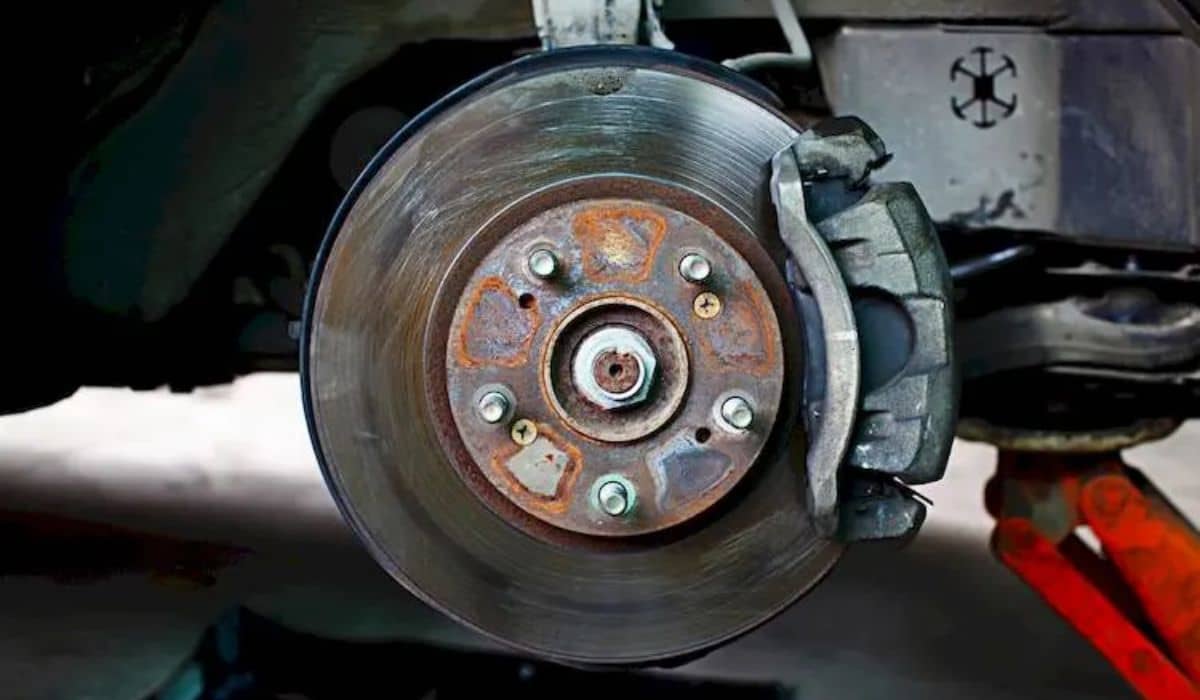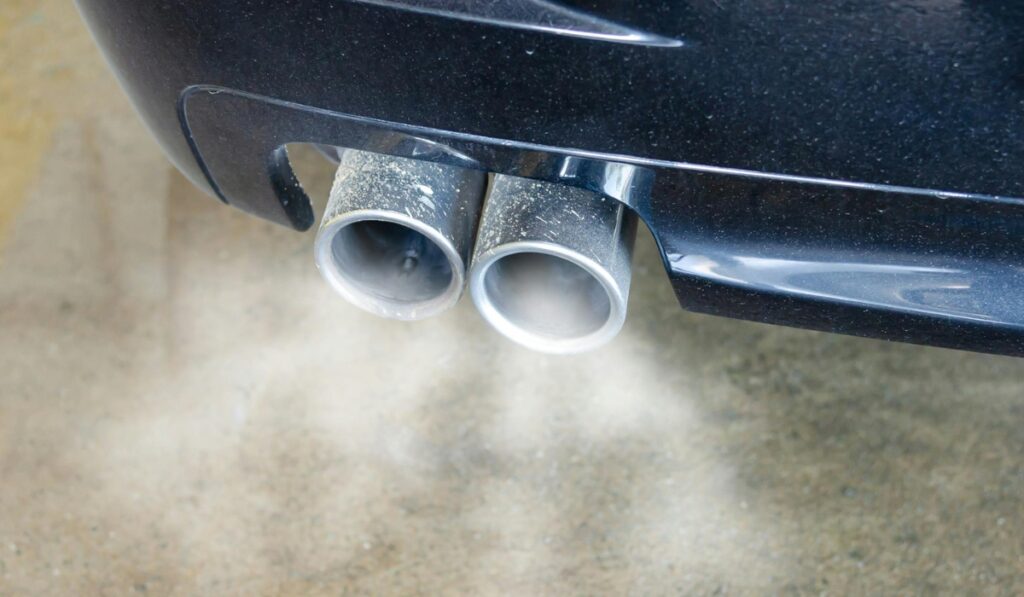Your car’s brakes are crucial to safety. They slow and stop your car, reducing accidents and assuring safe driving. Brake rotors are important in your braking system.
The huge, flat metal discs that your brake pads clamp down on to create friction to stop your vehicle are called brake rotors.
| Topic | Key Information |
|---|---|
| Brake Rotors | - Brake rotors are flat metal discs in the braking system. |
| - They create friction with brake pads to stop the vehicle. | |
| - Vented, slotted, and drilled rotors have specific designs. | |
| Signs of Bad Rotors | - Brake squeal, grind, or pulse |
| - Brake vibrations | |
| - Greater stopping distance | |
| - Uneven brake pad wear | |
| - Braking causes steering wheel shaking | |
| - Burning smell after braking | |
| - Soft brake pedal | |
| - Scores or grooves on rotors | |
| - Dashboard warning lights | |
| - Difficulty stopping in wet conditions | |
| Bad Rotors Causes | - Overheating brakes |
| - Rotor rusting due to moisture | |
| - Improper brake pad installation | |
| - Excessive forceful braking | |
| - Neglecting brake maintenance | |
| Handling Bad Rotors | - Visual inspection of rotors |
| - Brake pad replacement if worn | |
| - Rotor resurfacing or replacement based on damage | |
| - Brake fluid check and replacement | |
| - Seek professional help if uncertain | |
| Rotors Health | - Regular rotor checks for wear and damage |
| - Regular brake fluid maintenance | |
| - Gentle, gradual braking to reduce rotor stress | |
| - Use high-quality brake pads | |
| - Seek professional care for maintenance |
Understanding Brake Rotors
Before discussing Signs of Bad Rotors, we must define brake rotors and how they work. The main components of your car’s braking system are brake rotors, also known as brake discs.
The brake pads and their circular, flat metal discs provide deceleration friction. After pressing the brake pedal, the brake pads grip on the rotors, creating heat and friction for braking.
Vent Rotors
Many high-performance and heavy-duty automobiles employ vented rotors. Vents separate the friction surfaces in these rotors.
These tubes improve heat dissipation, reducing warping and overheating. Vented rotors are excellent for high-stress, hot brake situations due to their higher cooling capacity.
Slotted Rotors
Grooved rotors have slots carved into their surfaces. Heat dissipation is improved by these slots, preventing brake fade. Racing and heavy-load cars use slotted rotors for braking.
Drilled Rotors
As its name implies, drilled rotors feature holes in their surfaces. Cooling and rotor weight reduction are the main goals of these perforations.
They crack more easily but can improve performance in certain scenarios. Thus, performance and sports automobiles have drilled rotors.
Signs of Bad Rotors
Here are some symptoms that your rotors require maintenance. Early detection of these indications can save you money on costly repairs and improve your driving safety.
Brake Squeal, Grind, Or Pulse
Maintaining a safe and reliable car requires monitoring aberrant sounds and sensations. Squealing, grinding, or pulsing brakes may indicate brake rotor difficulties. These symptoms may indicate brake rotor wear.
Grinding or pulsating brakes may indicate damaged or uneven rotors, while squealing brakes indicate thin brake pads. These faults must be addressed immediately to prevent further braking system damage and reduce your vehicle’s stopping power.
For best performance and road safety, have a professional technician inspect and perhaps replace your brake rotors if you observe any of these indicators.
Brake Vibrations
Drivers often experience braking tremors. This can be felt in the steering wheel, brake pedal, or entire car. Vibrations can signal brake rotor issues as well as uneven tyre wear or suspension issues.
Warped or uneven rotors can create brake pad contact and vibrations during braking. A certified technician must inspect your brake system if you feel vibrations when braking.
They can evaluate the vibrations and determine if the brake rotors need resurfacing or replacement to restore safe and smooth braking.
Longer Stopping Distance
Rotor failure often causes increased stopping distances. When brake rotors are good, they create friction for brake pads to grasp and slow wheels. However, worn or damaged rotors may not provide adequate friction, increasing stopping distance.
This makes stopping slower and farther, which can endanger your road safety. If your car is stopping slower than usual, get your braking system and rotors evaluated for wear and damage. Paying attention to this issue can keep your brakes working and keep you safe.
Uneven Brake Pad Wear
Uneven brake pad wear is prevalent. Uneven brake pad wear can be caused by misaligned brake callipers or braking force distribution. This can cause uneven brake pad wear. Thus, engaging the brakes may cause vibrations or pulsations and variable braking performance.
Uneven brake pad wear might potentially ruin rotors ahead of time. To guarantee optimal braking performance and road safety, get your brake pads tested and replaced if you observe uneven wear.
Braking Causes Steering Wheel Shaking
Braking with a shaking steering wheel is another indicator of damaged rotors. Warped or unequal rotors can cause braking system imbalance. Thus, applying the brakes may shake the steering wheel.
This can be uncomfortable and dangerous because it impairs vehicle control. To restore smooth braking, have your rotors inspected and changed if your steering wheel shakes while braking. Ignoring this issue could damage the brake system and risk road safety.
Burning Scent After Braking
A burning scent after braking may indicate rotor problems. If your brake system smells like burned rubber or chemicals, it may be overheating. When rotors are worn or warped, brake pads brush against them and generate heat.
The burning smell may suggest worn brake pads that need replacement. Ignoring this scent and driving with hot brakes might reduce braking performance and cause accidents.
To find the reason of the burning smell and check your braking system, have a professional inspect your vehicle.
Soft Brake Pedal
A mushy brake pedal is another indicator of rotor problems. When you push the brake pedal, it may feel mushy or squishy. Air or moisture in the braking system can lower hydraulic pressure and reduce brake performance.
A mushy brake pedal can also be caused by worn brake pads, brake line leaks or master cylinder issues. This issue should not be ignored because it could increase stopping distances and accident risk.
A trained mechanic must evaluate your vehicle to diagnose and fix a spongy brake pedal.
Scores Or Grooves
Surface grooves or scoring may indicate that your vehicle’s rotors require maintenance. Check the smoothness and texture of your brake rotors. Deep grooves or scoring marks on the rotor indicate significant wear and tear.
As the brake pads press against the rotors during braking, friction and material removal create these grooves and scoring. Such damage might reduce brake power and cause rotor failure.
If you find grooves or scoring on your rotors, see a competent mechanic to assess the situation and determine the best course of action to keep your vehicle’s braking system running smoothly.
Dashboard Warning Light
Pay attention to dashboard warning lights when driving. These warning lights indicate urgent issues. A triangle in a circle warning light usually indicates traction control system issues.
This warning light may appear if the system malfunctions, suggesting diminished control and stability in bad driving circumstances. This warning light might affect road safety if ignored.
If this warning light or other unusual dashboard symbols appear, study the vehicle’s manual or seek expert help to diagnose and fix the problem.
Difficulty Stopping In Wet Conditions
In addition to warning signals, trouble stopping in wet circumstances may indicate braking system issues. Wet roads, especially with worn rotors, can make stopping difficult. Worn or deformed rotors may not offer enough friction for brake pads, reducing stopping power.
In wet or slippery circumstances, it takes longer to stop, making this unsafe. To guarantee optimal braking performance and road safety, get your rotors inspected and replaced if your vehicle is taking longer to stop or the brakes are less responsive on wet roads.
Bad Rotors Causes
Understanding the reasons of poor rotors helps you prevent them. Rotor issues often arise for several reasons:
Overheating Brakes Harm Rotors
Heating brakes is a major cause of rotor damage. Overheating brakes can destroy rotors. Overheated brakes can deform or break the rotor due to friction. Warping or cracking weakens the rotor, causing uneven braking, vibrations, and brake failure.
Overheating brakes must be addressed immediately to prevent rotor damage and ensure safe braking. Checking brake fluid levels, brake pad wear, and brake calliper performance can avoid overheating and rotor damage.
Rotor Rusting Is Caused By Moisture
Another major cause of corroded rotors is moisture. When rotors are exposed to rain, snow, or excessive humidity, corrosion develops. Over time, corrosion can erode the rotors’ metal surface, causing rust. Rust can roughen rotors, decreasing braking performance.
Roughness can produce uneven brake pad contact, causing vibrations and irregular braking. Rusted rotors also break or warp, reducing their efficiency.
Rotors must be kept dry and protected, especially in wet weather, to prevent corrosion and rust. A protective coating and regular cleaning can prevent moisture-related corrosion and extend rotor life.
Badly Placed Brake Pads Damage Rotors
Another major cause of damaged rotors is improper brake pad installation. Brake pads may not contact the rotor if improperly placed. Because of uneven friction and pressure during braking, some parts of the rotor wear faster than others.
The rotor may acquire grooves or uneven thickness, reducing its braking power. To avoid rotor wear, brake pads must be placed properly and tightened according to manufacturer instructions.
A competent technician can inspect and maintain the rotor to detect and fix installation faults before they cause serious damage.
Braking Hard Can Distort Rotors
Overuse of forceful braking might damage your vehicle’s rotors. The tremendous heat from brake pad-rotor friction can deform rotors when you use excessive brake force, especially in quick stops or going downhill.
Extreme heat causes the rotors’ metal to expand unevenly, bending them. Warped rotors cannot provide a smooth surface for brake pads to contact, reducing braking performance and perhaps causing vibrations or pulsations.
Be careful not to overbrake to prevent rotor warping and prolong the life of your braking system.
Ignoring Brake Maintenance Damages Rotors
Rotor integrity requires regular brake maintenance. Failure to fix worn brake pads, tainted brake fluid, or faulty brake callipers can harm rotors. Old brake pads can generate metal-to-metal contact, heat, and friction that can harm rotors.
Contaminated braking fluid can cause rotor corrosion and rust, threatening their structural integrity. Neglecting brake maintenance raises rotor damage risk and compromises braking system safety and performance.
To prolong rotor life and prevent damage, schedule regular brake checks and swiftly handle any maintenance needs.
Handling Bad Rotors
For road safety, fix defective rotors immediately if you notice any of them. If you feel your rotors require care, follow these steps:
Examine
First, visually inspect your rotors for damage, abnormalities, or scoring. Consider having a reputable mechanic inspect your rotors if you’re unsure of their condition or how to analyse them. They have the skills and equipment to assess thoroughly.
Brake Pad Change
If your brake pads are worn out, replace them. Worn brake pads reduce braking performance and hasten rotor deterioration. Brake pads must be replaced to guarantee proper operation.
Rotor Resurfacing/Replacement
Rotor resurfacing or replacement depends on damage. Resurfacing the rotor removes a thin coating to restore smoothness and function. When the damage is little, it works.
In extreme circumstances, rotor replacement may be best. Rotor repair keeps your braking system running smoothly without rotor damage.
Brake Fluid Check
Brake fluid must be checked together with rotors and pads. Make sure brake fluid is clean and at the proper level. Brake fluid must be checked and replaced regularly to preserve brake function.
Professional Help
If you’re unsure about your rotors or how to proceed, ask a skilled mechanic. Experts can detect and fix brake and rotor issues, making their help crucial. They may advise you, offer a solution, and fix your car’s braking system to keep it running smoothly.
Maintaining Healthy Rotors
Rotor issues are best prevented when possible. Rotors may be kept healthy and last longer with these tips:
Regular Checks
To avoid major concerns, examine your brake rotors regularly. Your rotors can be visually inspected for wear, damage, and unevenness to discover issues early and prevent further damage. Regular maintenance saves money and ensures road safety.
Brake Fluid Care
Maintaining healthy rotors and a working braking system requires regular brake fluid changes as suggested in your vehicle’s maintenance schedule. Fresh brake fluid maintains braking performance and minimises contaminants that can cause corrosion.
Soft Braking
Your driving habits can also affect rotor lifespan. Avoid quick or hard braking to avoid rotor heat and wear. Gradual braking protects your rotors and is safer. Anticipating stops and applying the brakes gradually reduces braking system stress.
Good Brakes
Purchase high-quality brake pads to ensure rotor health. The lifespan of rotors is extended by quality brake pads that wear evenly. The long-term benefits of rotor durability and braking performance make them worth the extra cost.
Expert Care
If you’re unsure about your braking system, professional maintenance and servicing is wise. A skilled mechanic can maintain your brakes and rotors. To maintain your braking system, they can check, diagnose, and prescribe preventive actions.
FAQ
What Are Brake Rotors, And Why Are They Vital In Automotive Braking?
Your car’s braking system relies on huge, flat metal brake rotors, commonly known as brake discs. They create friction with brake pads to slow and stop your vehicle.
When you press the brake pedal, the brake pads grip on the rotors, generating heat and friction to stop your car. For safe and effective braking, brake rotors must operate properly to provide a grip for brake pads.
What Are The Indicators Of Damaged Brake Rotors?
Bad rotors can cause brake squealing, grinding, or pulsing, vibrations when braking, increased stopping distance, uneven brake pad wear, a shaking steering wheel, a burning smell after braking, a soft or mushy brake pedal, surface grooves or scoring on the rotors, and dashboard warning lights related to the braking system.
What Damages Brake Rotors?
Brake rotors can deteriorate due to overheating from aggressive braking, moisture causing rust and corrosion, improper brake pad installation causing uneven wear, excessive forceful braking, and neglecting brake maintenance like worn brake pads, contaminated brake fluid, or faulty brake callipers.
How Can I Prolong Brake Rotor Life?
To keep brake rotors healthy, check for wear and damage, change the brake fluid as recommended in your vehicle’s maintenance schedule, avoid quick or hard braking to reduce heat and wear, buy quality brake pads that wear evenly, and get routine maintenance from a skilled mechanic.
What Should I Do If My Brake Rotors Need Repair?
First, visually inspect your brake rotors for damage and irregularities. Contact a trusted mechanic for a complete evaluation. Replace worn brake pads. Rotor resurfacing or replacement may be needed depending on deterioration.
Check your brake fluid level and cleanliness. Professionals can diagnose and fix brake and rotor issues to keep your braking system running smoothly.
Conclusion
For road safety, your brake rotors must be healthy. Understanding brake rotor basics, recognizing defective rotors, comprehending the root causes of rotor problems, and taking the proper procedures when problems develop will help your braking system work dependably.
Preventive procedures and healthy rotors can provide safe and effective braking for years. Rotor health isn’t just about car maintenance; it’s about your and others’ safety.





